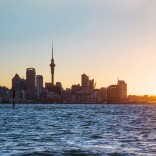Islands in Auckland
The sparkling sheltered waters of the Hauraki Gulf are sprinkled with islands of all sizes. Many can be visited by ferry for the day and a handful of those come with overnight accommodation. Each has its own character and unique attractions, so here's an introduction to the top Auckland islands, to help you find your perfect escape.
Before travelling to one of the conservation islands, check your bags and belongings for stowaway pests, such as rodents, ants and other insects. Also, clean your footwear before boarding the ferry to avoid bringing unwanted seeds and soil diseases to the island.

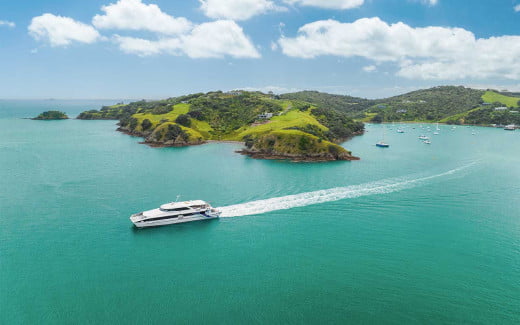
Explore Waiheke Island beaches, cafés and wineries
Once home to farmers and artists, Waiheke Island is now a thriving visitor destination and an internationally recognised wine region with more than 20 vineyards. The introduction of fast ferry services opened the island up to day-trippers and resident commuters. They're drawn to the island's beach-focussed, arty, foodie and environmentally aware lifestyle.
Waiheke has a wonderful array of things to see and do, from winery tours and award-winning restaurants to white-sand beaches and coastal walks. Most of the shops, cafés, restaurants, and popular beaches are on the western half of the island, nearest to the ferry terminal. Oneroa, the main town on Waiheke Island, is a bustling village set above a beautiful north-facing sandy beach. Further east is Palm Beach and the white sands of Onetangi. Beyond that there's a long loop road around the eastern end of the island. This route passes Stony Batter Reserve, a historic walk with spectacular views from a series of impressive WW2 gun emplacements. You can also take a guided tour through the subterranean Fort Stony Batter Tunnels that was commissioned in 1942 under absolute military secrecy. The complex comprises 1.2km's of subterranean passages, chambers and stairwells all tunnelled by hand.
The Te Ara Hura Walk Waiheke Network is a collection of walks where you can explore the coastline, pass through native bush and visit historic sites. There's a great range of walks, from short and easy through to more challenging, and most of them are connected. You can start at any point, finish wherever you want and go in any direction. A Te Ara Hura adventure can be built around overnight stays, tastings or great meals at vineyards, and top-up stops at cool cafes.
EcoZip Aventures is Auckland's Original & Most Spectacular Zipline Experience over Native Forest that's only a short 40-minute ferry ride from downtown Auckland. The extensive 3-hour zipline adventure over native forest is centrally located in the heart of Waiheke's wine country, so you get to see more of Waiheke in one day. They also include all inclusive group packages.
Man O' War Winery on Waiheke Island is a top-tier destination for wine lovers and adventure seekers alike. Visitors can indulge in premium wines from the iconic Flagship and Kulta Collections, enjoy breathtaking coastal views, and embark on the Forest Flight - a new zipline and forest walk through the mesmerising Kauri Forest. The winery also offers an ideal spot for dining, events, and private gatherings, all set within a stunning vineyard landscape, making it a must-visit destination for a luxurious and immersive Waiheke experience.
Ferries to Waiheke depart regularly from Auckland's CBD ferry terminal and Devonport. The pleasant 35-45-minute trip passes several islands of the inner Hauraki Gulf. Top tip: secure your ferry seat with ahead of time with Fullers360 Waiheke Reserve. At the Waiheke Matiatia terminal, public bus services, taxis, tour operators, and car and bike hire operators can carry you off to the island experiences that most appeal to you.
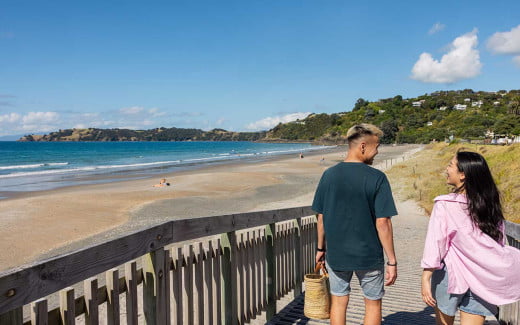

Step back in time on Aotea/Great Barrier Island
Lying 100km northeast of downtown Auckland on the outer edge of the Hauraki Gulf, Aotea/Great Barrier Island, is the fourth largest in New Zealand's main island chain. Historically a source of minerals and timber, today more than two-thirds of the island is set aside as a public-access conservation park. Visiting this wonderfully relaxed and natural island is like stepping back in time. The ocean-facing east coast is known for high cliffs and beautiful white-sand surf beaches, while the west coast is home to fiord-like coves and sheltered sandy bays popular with boaties. The mountainous centre of the island is covered in native forest; the highest peak, Hirakimata (Mount Hobson), rises to 621m above sea level.
Walking and hiking trails range from 30 minutes to several days and carry you through spectacular landscapes with panoramic views. There's even one trail - Kaitoke Hot Springs Track - that leads to geothermally heated pools. Fishing and diving around the Barrier are legendary and local charter operators will get you to the best spots. With a resident population of less than a thousand and no streetlights or public electricity supply, Great Barrier was the first recognised Dark Sky Sanctuary island in the world. The stargazing there is truly amazing and local Dark Sky Ambassadors run guided evenings to help you learn more about the galaxies, stars and planets.
The Glenfern sanctuary on Great Barrier Island prioritizes native plant restoration, removing non-native species, and boasts the highest number of native lizards in New Zealand
Aotea Great Barrier Island is a 30-minute flight or 4.5 hour ferry trip from Auckland. Accommodation ranges from backpacker lodges, B&Bs and bookable private holiday homes to motels and luxury lodges. There's no public transport on the island, but there are taxis, shuttles, and passenger transport operators, as well as car, scooter and e-bike hire companies. In summer, the number of people on the island quadruples, so it pays to book accommodation, flights and transport well in advance.

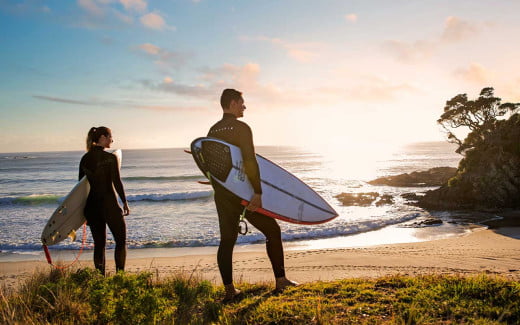
Climb and explore Rangitoto Island
Emerging from the sea only 600 years ago, Rangitoto is the youngest island in the Hauraki Gulf and the closest to downtown Auckland. Almost perfectly symmetrical, its gently sloping volcanic cone is 5km wide and 260m high. Landing on Rangitoto is like stepping onto another planet. Remarkably, native ferns and trees have thrived on this rocky volcanic landscape and the island is now home to New Zealand's largest pōhutukawa forest, resplendent in red flowers during summer.
Managed by the Department of Conservation, Rangitoto is a predator-free sanctuary with a flourishing bird life. The most popular walking track leads up through the lava fields to the summit, which takes about an hour. From there the views extend in every direction, providing great photos of the city, North Shore beaches and other islands in the Hauraki Gulf. It's a great place for a picnic lunch. Near the summit the track passes lava tunnels or caves, which you can explore if you bring a torch. A four-wheel drive train provides another option for exploring the island. Departing from the ferry wharf, it stops near the top, where there's a boardwalk and steps to the summit.
No one lives on Rangitoto, there's no shop or café and, apart from a few rentable historic baches, no accommodation. It's a wonderful day-trip destination that begins with a 25-minute ferry ride departing from the downtown terminal and some sailings stopping at Devonport on the way. Auckland Sea Kayaks offer concessions to facilitate tours to Rangitoto Island with their daytime and sunset kayaking tours. Details are shown here.
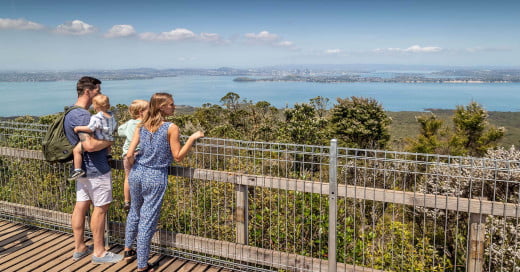

Go birdwatching on Tiritiri Matangi Island
Only 30km from downtown Auckland and 4km east of Whangaparaoa Peninsula, Tiritiri Matangi is remarkable island wildlife sanctuary that's open to the public. From 1902 to 1971, the island was leased from the government and operated as a private farm, an exercise that left very little native vegetation. Today, two-thirds of the island is covered in native forest, thanks to the efforts of countless volunteers. The island has also been cleared of predator mammals, so that endangered bird species can flourish.
Now managed by the Department of Conservation and the Supporters of Tiritiri Matangi organisation, the island welcomes more than 20,000 visitors a year. Knowledgeable volunteers provide 90-minute small-group guided tours that you can book in advance. You can request this tour booking when booking ferry tickets with Explore Group. You're also free to roam the island self-guided. There are several well-marked walking trails that range from 30 minutes to three hours. The views are magnificent and two of the beaches are perfect for a swim. Most of the birds on the island are quite used to visitors. With no fear of predators, they'll flit about, rest, bathe and feed remarkably close to you and your camera. The island holds precious populations of kōkako, tīeke/saddleback, kiwi pukupuku, hihi, toutouwai, takahē and tuatara that can't easily be seen anywhere else around the Auckland region, so glimpsing these rare animals is a highlight for many visitors.
Tiritiri Matangi is also home to New Zealand's oldest working lighthouse. Close to the lighthouse there's a visitor centre with complimentary tea and coffee, a gift shop that sells cold drinks and a shared bunkhouse you can book (well in advance) for an overnight stay. Wednesday to Sunday and on public holidays, the ferry departs in the morning from the Auckland CBD terminal from, then returns from the island in the afternoon. The trip takes 75 minutes, stopping at Gulf Harbour on the Whangaparaoa Peninsula each way.
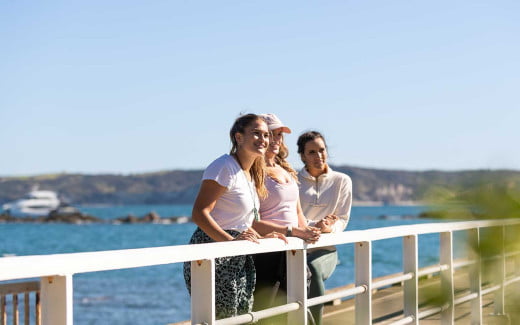

Follow Governor Grey's footsteps on Kawau Island
At 8km long and 5km wide, Kawau is one of the larger islands of the Haruaki Gulf. It's about 8km by ferry or water taxi from Sandspit Wharf, which is east of Warkworth and just over an hour north of Auckland by car.
Kawau's unique character rests on the historic shoulders of Sir George Grey, who owned the island from 1862 to 1888. Within the sheltered haven of beautiful Bon Accord Harbour, which almost bisects the island, there are many picturesque bays. The most remarkable is Mansion House Bay. Here you can tour Sir George Grey's stately home, then stroll along the road that his carriage (pulled by two zebras!) used to take. While the zebra that Grey introduced weren't especially happy on the island, the monkeys did so well they had to be eradicated. Notable legacies of Grey's obsession are peacocks, wallabies and kookaburras. It's hard to miss the peacocks, because they strut around Mansion House Bay like they own the place. But the wallabies, which were a threat to native flora and fauna, are now all but gone from the island. Some wallabies were returned to Australia where their particular species had become rare and endangered.
From the historic coach road, a track leads to the picturesque ruins of a seashore copper mine - the oxidised copper colours are truly amazing. Another great Kawau walk is the Redwood Track, which reveals an interesting collection of exotic trees planted by Grey - redwoods, Australian bush cherry and bunya-bunya pines, to name just a few. A visit to the yacht club bar across the harbour will help you to connect with the island's own brand of hospitality.
Kawau Cruises ferries depart from Sandspit Wharf mid-morning daily. Prior bookings are required. The return trip departs from Mansion House mid-afternoon. There's a café at Mansion House Bay, but the opening dates and times vary - check ahead or bring a picnic lunch. One of the cruises, the Royal Mail Run, offers an optional BBQ lunch on board the ferry.
